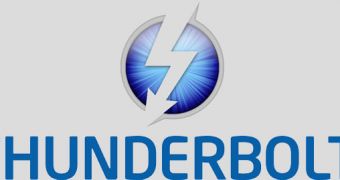Introduced earlier this year, together with the 2011 Mac BookPro, Intel's Thunderbolt technology isn't yet available in any retail products other than Apple's notebook, but Intel hopes this will change later this quarter when the company releases the Thunderbolt development kit.
The Thunderbolt technology was developed in order to provide a unified interface with enough bandwidth to replace all the current connection buses, such as SCSI, SATA, USB, FireWire or PCI Express.
Although this first iteration of Thunderbolt is still far away from reaching that goal, it still manages to join together the PCI Express and the DisplayPort interfaces and can provide, in theory, 20Gbps of upstream and 20Gbps of downstream bandwidth (via two 10Gbps bidirectional channels).
Thunderbolt can also daisy chain up to 7 devices and delivers a maximum of 10W of power without requiring any additional connectors.
The interface shares connectors and cabling with mini-DisplayPort and Intel promises these will remain unchanged when the technology switches from electrical to optical cables (sometime later this year).
Since Thunderbolt was introduced, quite a few companies have announced their support for the technology, but, as we speak, the only device to include this interface is Apple's 2011 Mac BookPro.
However, Intel is working with its partners to develop new products around the interconnect, and LaCie and Western Digital have already demonstrated portable storage products based on Thunderbolt.
Other companies, such as Canon and Sony, have also expressed their support for the technology, and an HP spokesman said they were evaluating Thunderbolt for implementation into a range of notebook computers.
The release of the Thunderbolt development kit could, however, entice more companies to develop such products, and could eventually lead to better market availability.
Thunderbolt was previously known as Light Peak, but Intel has decided to change its name when it switched from using optical wires to regular copper wires. (via Kit Guru)

 14 DAY TRIAL //
14 DAY TRIAL //